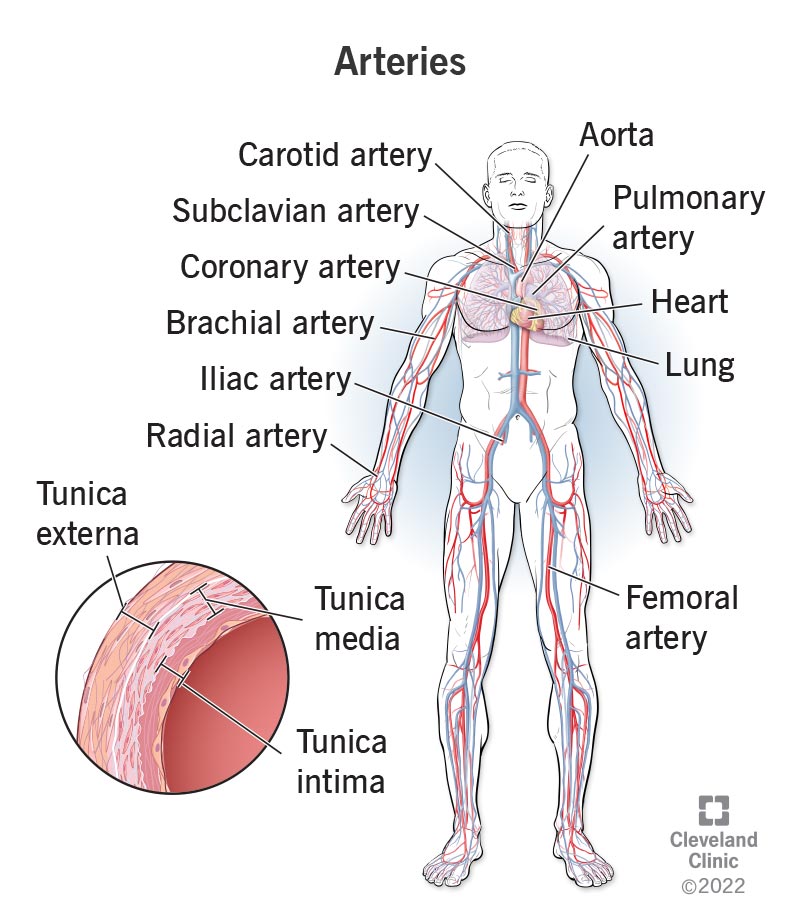Arteries, a critical part of your cardiovascular system, are blood vessels that distribute oxygen-rich blood to your entire body. These tube-like vessels and the muscles inside them ensure your organs and tissues have the oxygen and nutrients they need to function. A condition called atherosclerosis can slow down blood flow through your arteries.
Advertisement
Cleveland Clinic is a non-profit academic medical center. Advertising on our site helps support our mission. We do not endorse non-Cleveland Clinic products or services. Policy

Arteries, part of your circulatory (cardiovascular) system, are the blood vessels that bring oxygen-rich blood from your heart to all of your body’s cells. They play a crucial role in distributing oxygen, nutrients and hormones throughout your body. Arteries keep your body alive and healthy by delivering what your cells and tissues need.
Advertisement
Cleveland Clinic is a non-profit academic medical center. Advertising on our site helps support our mission. We do not endorse non-Cleveland Clinic products or services. Policy
You have two types of arteries that have slightly different functions. Both have a role in carrying oxygen-rich blood from your heart to your body’s tissues.
The first type, elastic, is like when a football player catches the ball, absorbing the force from the throw. This is the type that gets your blood from your heart before passing it on to other arteries.
The second type, muscular, is like when they run down the field with the ball, getting it to where it needs to go. This is your blood going to your body’s tissues.
The two types of arteries are:
Arteries
Veins
Advertisement
Your arteries carry blood that has oxygen and nutrients in it. Your heart pumps oxygen-rich blood into the biggest artery in your body — your aorta. This branches off into parts that feed smaller and smaller arteries, eventually reaching your entire body.
Your arteries supply all of your organs with blood. Your blood contains oxygen and nutrients, which every organ in your body needs to function.
Specific arteries provide blood to organs or certain parts of your body, such as:
Your pulmonary artery is the only artery that carries deoxygenated blood. This artery takes blood from your heart to your lungs to get oxygen.
Your arteries start branching out from your aorta, which gets blood from your heart. From there, arteries continue to branch out into smaller and smaller vessels going all through your body.
Arteries look like tubes. They have thicker and more muscular walls than veins so they can handle the force of blood coming from your heart’s left ventricle. Think of them like your furnace ducts (but flexible) that take warm air throughout your house when your furnace is running.
Your aorta, your largest artery, is about 10 millimeters (mm) to 25 mm (.4 inch to .9 inch) in diameter. Other arteries can be 3 mm to 5 mm (.11 inches to .19 inches) in diameter, while the smallest arteries, arterioles, can be .30 mm to .01 mm in diameter.
Your arteries have three layers:
Conditions that can harm your arteries include:
Advertisement
Some conditions, like high blood pressure and high cholesterol, don’t have symptoms. You may not notice your arteries getting stiffer or clogging with plaque (cholesterol and fat) that collects over time.
These problems make it harder for blood to move through your arteries, and can lead to narrow or blocked arteries.
Symptoms of artery conditions include:
These types of imaging can help your healthcare provider see your arteries:
Treatments for diseases affecting arteries range from medication to surgical procedures, including:
Things you do to keep your heart healthy will also help your arteries. You can:
Advertisement
Although most people focus on their heart when they think about the cardiovascular system, arteries have an important role, too. They supply your body with oxygen, nutrients and other necessary elements that travel in your blood. When you take care of your arteries, they take care of you. Regular exercise and a diet low in saturated fat can help your arteries keep blood flowing without interruption or slowdowns. Because high blood pressure and high cholesterol usually don’t have symptoms early on, it’s important to ask your healthcare provider to check them to make sure they’re normal, and treat them if they’re not.
Advertisement
Cleveland Clinic’s primary care providers offer lifelong medical care. From sinus infections and high blood pressure to preventive screening, we’re here for you.

Last reviewed on 04/30/2022.
Learn more about the Health Library and our editorial process.